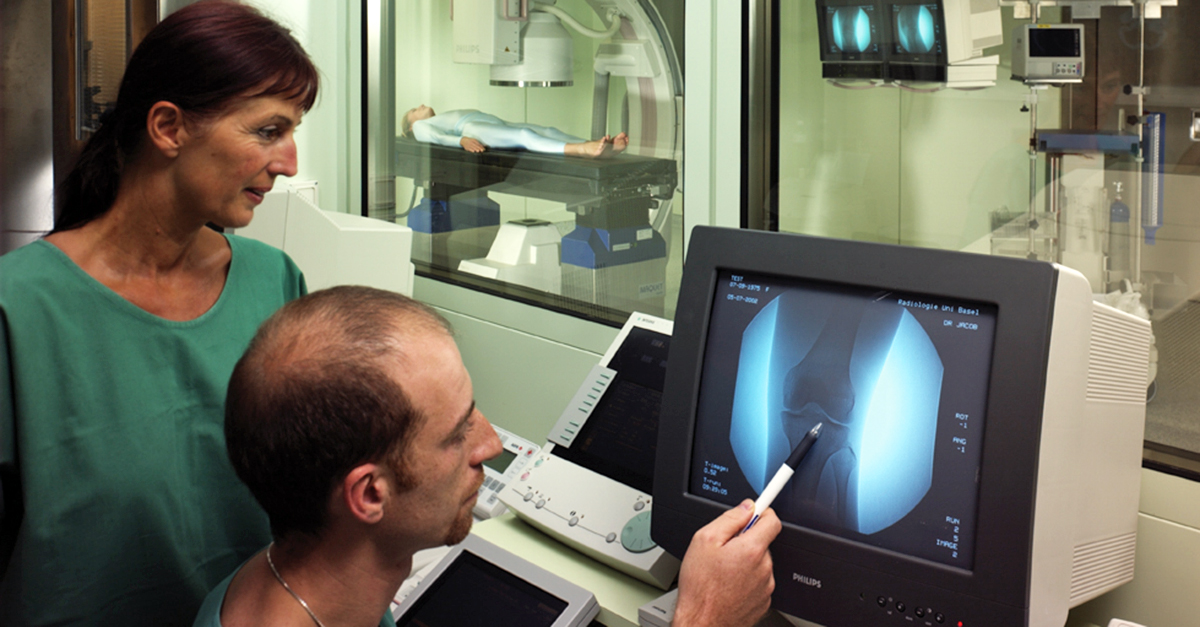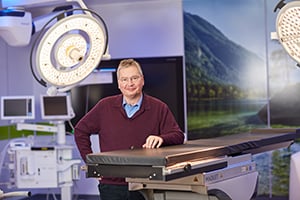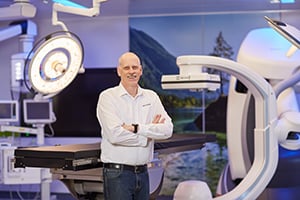Twenty years ago when Getinge together with imaging partners started providing hospitals with Hybrid operating rooms (Hybrid ORs), the first stars were AWIGS and VIWAS – the synthesis of operating table and imaging system. Meet two Getinge employees who share their stories now that Getinge celebrates 20 years of driving the future of the Hybrid OR.

Back in the days in the late 90’s when Getinge started pioneering Hybrid ORs, the OR table used was called AWIGS and VIWAS was the system connecting it to a computed tomography scanner (CT), angiography system or magnetic resonance imaging scanner (MRI).
Thomas Krickeberg, Application Specialist at Getinge and former OR nurse, was involved in many of the early installations as he trained medical teams on how to get started.
 “I trained both customers and Getinge staff and supported our R&D team. I saw the customer’s needs changing a lot during these years, from mainly doing open surgeries towards a bigger demand on performing endoscopic and image guided surgeries,” Thomas remembers.
“I trained both customers and Getinge staff and supported our R&D team. I saw the customer’s needs changing a lot during these years, from mainly doing open surgeries towards a bigger demand on performing endoscopic and image guided surgeries,” Thomas remembers.
An OR is a critical environment, but since in the Hybrid OR the patient is never lifted even if he or she has to be moved, it is easier to avoid risks. Also, the trauma patients who come here are often multiply injured and in the absolute worst cases it is hard to even touch them without hurting them more. Thomas explains:
“In the Hybrid OR the patient stays on the same surface during scanning and surgery which is safe and gentle for both patient and staff. This can save the lives of many trauma patients as it quickly provide detailed information on injuries. The 3D images are reviewed instantly and the surgeon can go back to the surgery at once, or discontinue it depending on what the images show. It is very timesaving.”
During one training session at a customer there was actually a situation where a trauma patient was admitted to the hospital and Thomas got to be part of caring for the patient in the newly installed Hybrid OR.
“We saved this patients life, and it was not just by using one product – it was a full procedure carried out in the Hybrid OR. Although I love my current profession I sometimes miss being a nurse. That’s why working this close together with our customers is a good solution for me. I love it,” says Thomas.
Another aspect where his knowledge became useful was in cooperation with the R&D team.
 “It was very valuable having Thomas as a trainer, he provided fantastic field input on customer needs early on which we could take into consideration in the product development,” remembers Jan Donat Olszewski, Senior R&D team leader at Getinge.
“It was very valuable having Thomas as a trainer, he provided fantastic field input on customer needs early on which we could take into consideration in the product development,” remembers Jan Donat Olszewski, Senior R&D team leader at Getinge.
Jan has been working at Getinge for 32 years now, and is often referred to as “Mr. AWIGS” by his colleagues.
“I was project manager as well as engineering manager for both AWIGS and VIWAS; a stable and reliable mix of solutions that were perfect for the Hybrid OR adding great clinical benefits.”
But as the need for using more than one imaging system grew over the years and it was not possible to use the same transfer board to move the patient between different scanners, AWIGS and VIWAS got their successors. And today Jan tells that the main invention he has been part of creating actually is the new table tops for the transfer board, the actual surface where the patient stays at all times, even though different imaging modalities are used.
“In the recent years we have started offering multimodality solutions, which means just that: combining more than one imaging system with the OR table. We have a whole new patient transfer system called PILOT. And at heart of the system we find the transfer board, the puzzle piece that allows the seamless transfer to take place.”
PILOT was launched quite recently through a fruitful collaboration with Siemens Healthineers and it is the perfect solution for the Multi-modality Hybrid Suite.
“It is a patient-centered transfer system that eliminates the barriers to using intraoperative Angio, CT, and MR imaging at any point during the procedure. This new technology ensures that the patient remains stable in the intended treatment position while all imaging tasks are centered around,” explains Jan.
After 20 years of providing innovations and training for the Hybrid OR, both Thomas and Jan are in agreement: there are more to do.
“Seamless integration is about more than delivering a turnkey solution. It is about optimizing workflows and workspaces, synchronizing components, and implementing international hygiene standards throughout the room. Each Hybrid OR is tailor-made as our customers have different needs. We have a huge experience now given 20 years of creating these solutions together with our partners and customers and the future looks exciting,” says Thomas.
In 2019 Getinge celebrates driving the future of surgery for 20 years, read more about it: Twenty years of driving the future of surgery